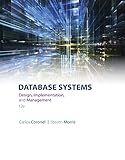Best Database Tools to Buy in December 2025

Database Systems: Design, Implementation, & Management



Database Systems: Design, Implementation, & Management



Database Systems: Design, Implementation, & Management



Concepts of Database Management (MindTap Course List)



Statistics: A Tool for Social Research and Data Analysis (MindTap Course List)



Bioinformatics for Beginners: Genes, Genomes, Molecular Evolution, Databases and Analytical Tools



Data Mining: Practical Machine Learning Tools and Techniques (Morgan Kaufmann Series in Data Management Systems)
- EXCLUSIVE 'NEW' STYLE BOOSTS CUSTOMER INTEREST AND EXCITEMENT.
- MODERN DESIGN ENHANCES USER EXPERIENCE AND SATISFACTION.
- LIMITED-TIME OFFER CREATES URGENCY FOR IMMEDIATE PURCHASES.



The Manga Guide to Databases (The Manga Guides)



Database Design for Mere Mortals: A Hands-On Guide to Relational Database Design


To create a view in Oracle, you can use the CREATE VIEW statement followed by the view name and the SELECT query that defines the view. Here is an example:
CREATE VIEW view_name AS SELECT column1, column2, ... FROM table_name WHERE condition;
Make sure you replace "view_name" with the desired name for your view and "table_name" with the name of the table you want to create the view from. The SELECT query should include the columns you want in your view, and you can also add a WHERE condition to filter the data if needed.
Once you have executed the CREATE VIEW statement, the view will be created and stored in the database. You can then query the view as if it were a regular table, using the view name.
Please note that views provide a way to present a subset of data from one or more tables, and they do not store any data themselves. Any changes made to the underlying tables will immediately reflect in the view.
What is the purpose of creating a read-only view in Oracle?
The purpose of creating a read-only view in Oracle is to provide a way for users or applications to access specific data in a database without the ability to modify it. This can be useful in scenarios where users only require read access to data for reporting, analysis, or security purposes.
By creating a read-only view, the underlying data can be hidden or restricted to present a simplified and controlled view to the users. It also ensures data integrity, as it prevents accidental or unauthorized changes to the data.
Additionally, a read-only view can improve performance by predefining complex queries or calculations and caching the results. This can help optimize the overall database performance and reduce the load on the underlying tables.
Overall, creating a read-only view in Oracle offers a secure and efficient way to provide controlled access to data while maintaining the integrity and performance of the database.
How to define a view in Oracle?
In Oracle, a view is a virtual table that is based on the result of a SQL query. It can be defined using the CREATE VIEW statement.
The syntax for creating a view in Oracle is as follows:
CREATE [OR REPLACE] [FORCE | NOFORCE] VIEW view_name [(column_name1, column_name2, ...)] AS SELECT column_name1, column_name2, ... FROM table_name [WHERE condition];
Here's a step-by-step guide to defining a view in Oracle:
- Begin by opening the Oracle SQL Developer or any SQL client.
- Decide on the name of the view and the columns that the view will consist of. Additionally, determine the table or tables from which the view will retrieve data.
- Use the CREATE VIEW statement to define the view. You can use the optional OR REPLACE keyword to replace an existing view with the same name, and the optional FORCE | NOFORCE keyword to specify whether the view should be created even if there are dependencies or not. Specify the view name and list the columns that the view will include in parentheses after the view name.
- After defining the view, use the SELECT statement to define the query that will retrieve data for the view. Specify the columns to include in the view.
- Optionally, you can use the WHERE clause to filter the data returned by the view based on certain conditions.
- Execute the CREATE VIEW statement to create the view.
Example:
Let's say we want to create a view named "employees_view" that includes the employee ID, name, and department from the "employees" table.
CREATE VIEW employees_view (employee_id, employee_name, department) AS SELECT employee_id, first_name || ' ' || last_name, department FROM employees;
In this example, the view "employees_view" is created with the specified columns and retrieves data from the "employees" table. The employee ID is renamed as "employee_id", the combined first name and last name is named as "employee_name", and the department remains unchanged.
How to create a simple view in Oracle with a single table?
To create a simple view in Oracle with a single table, follow these steps:
- Open Oracle SQL Developer or any Oracle database management tool.
- Connect to the Oracle database using your credentials.
- Open a new SQL worksheet.
- Write the CREATE VIEW statement to create the view. The syntax is as follows: CREATE VIEW view_name AS SELECT column1, column2, ... FROM table_name; Replace view_name with the name you want to give to the view, column1, column2, ... with the columns you want to select from the table, and table_name with the name of the single table you want to create the view with.
- Execute the SQL statement. If there are no syntax errors and the table exists, the view will be created successfully.
Here's an example to create a simple view called "employees_view" with columns "employee_id" and "employee_name" from the table "employees":
CREATE VIEW employees_view AS SELECT employee_id, employee_name FROM employees;
Note that you can also add additional clauses, such as WHERE or GROUP BY, to the SELECT statement within the CREATE VIEW statement if desired.
What is the difference between an inline view and a regular view in Oracle?
In Oracle, the main difference between an inline view and a regular view lies in their definitions and usage.
- Inline View:
- An inline view, also known as a subquery factoring or a derived table, is a temporary result set that is created within a SQL statement.
- It is defined within the FROM clause of the main query and enclosed within parentheses.
- The result of the inline view is accessible only within the scope of the main query.
- It improves the readability and performance of the query by allowing the transformation and filtering of data before joining with other tables or aggregating.
- Inline views are not saved as database objects and do not have a name or persistent storage.
Example syntax: SELECT * FROM (SELECT column1 FROM table1) inline_view;
- Regular View:
- A regular view is a named and stored database object that acts as a virtual table based on the result of a query.
- It can be referenced by multiple queries, allowing for code reusability and easier maintenance.
- The view is saved in the database and can be accessed by different users with appropriate privileges.
- Views are typically used to encapsulate complex queries, provide a simplified interface to query data, and control access to sensitive information.
- Changes made to the underlying tables reflected in the view's data upon querying.
Example syntax: CREATE VIEW view_name AS SELECT column1 FROM table1;
Overall, inline views are used for smaller temporary result sets within a single SQL statement, while regular views are more suitable for reuse, encapsulation, and simplified access to complex queries.
How to create a view in Oracle?
To create a view in Oracle, you can use the CREATE VIEW statement. Here's the syntax:
CREATE VIEW view_name AS SELECT column1, column2, ... FROM table_name WHERE condition;
Here's a breakdown of the syntax:
- view_name: This is the name you want to give to the view.
- column1, column2, ...: These are the columns you want to include in the view. You can specify one or more columns.
- table_name: This is the name of the table or tables you want to retrieve data from.
- condition: This is an optional condition that specifies which rows to include in the view.
Here's an example of creating a view in Oracle:
CREATE VIEW employees_view AS SELECT employee_id, first_name, last_name, hire_date FROM employees WHERE department_id = 50;
In this example, we create a view named "employees_view" that includes the employee_id, first_name, last_name, and hire_date columns from the employees table. The view only includes employees from the department with department_id = 50.
What is the purpose of including a WHERE clause in a view definition?
The purpose of including a WHERE clause in a view definition is to filter the data that is displayed by the view. By specifying criteria in the WHERE clause, you can limit the rows that are returned by the view. This allows you to create a customized view that displays only the data that meets certain conditions, making it more convenient and efficient to work with the data.
